Well, what a project!
For those who haven’t been following my progress lately, I built ClassicAPI VP26 and Sound Skulptor MP73 microphone pre-amplifiers ( pre-amps ) to use on the album I am currently producing for Lee Safar.
Whilst the pre-amps themselves were fully self-contained kits, the processing of putting them into a 1u rack case, along with some of my own customizations, was a much more time-consuming and complex project than I originally expected.
I am happy to say that as I type this, they are completely working and racked up beautifully in a case I cut with my own hands ( no CNC machines were used this time, just a good old drill press and a bunch of manual labour! ). The next time I undertake such a project, I think that I’ll be relying more on automation, but I wanted to get my hands dirty this time.
Picking up from my last pre-amp post, I rounded up the last part of the build by assembling everything roughly, and running through the MP73 calibration procedure for a few hours, running a bunch of test tones to and from the unit, and calibrating things like the clipping LEDs etc.
At that point in time, the whole thing looked a little like this:
Here you can see the test tones are being fed in to the MP73:
Since the MP73 is designed for a custom Sound Skulptor case, I had to improvise on some of the wiring:
I also had to ensure that the VP26 kept working with the MP73 running simultaneously, since the JLM Audio Powerstation power supply I used was providing all of the various voltages I needed:
Here was the first image I took of the clip lights on the MP73 operating correctly. That was an exciting time!
From that point, all that was remaining was the hefty final wiring, which included an extremely cool customization feature that I added for the specific purpose of being able to get a bunch of different tones for the recordings we are going to do of Lee’s vocal.
The Customizations:
Basically, you can see here, an unlabelled little switch just to the right of screen:
When it’s sitting “up”, which is the “off” position – it has no effect. but when you flick it down to the “on” position, it does something pretty cool. It turns on a relay that bridges the two inputs ( if we label the VP26 circuit as pre-amp A, and the Sound Skulptor MP73 as pre-amp B ) so that the inputs for A and B are connected. This means that with the switch down, plugging a single microphone into input A, drives BOTH the preamps A & B, and produces distinct, isolated outputs from both the A & B channels.
This is an intentional cost-cutting feature, designed because we decided not to buy two microphones. Instead, I wired in this bridging mechanism, allowing us to get the phase-accurate sound of BOTH the API and Neve-style pre-amplifiers at the same time, from one source.
This allows us to then record the two different flavors of sound to the Left and Right inputs of a standard sound-card. Cool huh? 😉
The second customization again relates to the bridging swtich, but allows you to still safely use phantom power. With the bridging switch in the “off” position, channels A and B have separately controlled independent phantom power switches. However, with the bridging switch “on”, the phantom power is disconnected from the B channel, and instead, the phantom power from channel A is used only. Since the inputs are bridged, this just means that you get the correct phantom power, controlled by channel A’s phantom power switch, without the hassle of having to worry about the current setting of channel B’s phantom power switch.
It’s basically just a safety feature that allows phantom powered microphones to be used in the bridging confuguration.
I can’t WAIT to use this feature and be able to blend two independent colours of Lee’s voice together to find the right tone.
The Final Images:
Here it is, completely finished, but with the lid off:
And here are the carefully wired internals:
Followed by some close-ups, that show some of the features I’ve discussed:
Here you can see the relay driving the bridging input configuration. It sits right near the inputs to keep the length of cables as small as possible. I didn’t want to run audio cable all the way from the rear inputs, to the front switch, and then back again, so this was a good alternative solution:
And here are the rest of the internal pics:
Since Lee needs to take this back to LA with her, I’ve included the ability to switch between 120V and 240V input power:
Looking good!
And here it is, trying out a rack space for size, alongside my previous build, an SB4000 SSL-style Bus Compressor ( thanks ruckus! ):
For any details about this, please let me know and I’ll give you whatever information I can.
It was a really fun and challenging project and I can’t wait for Lee to arrive in Australia to start recording the vocals for her album through these.
Sound samples coming soon….

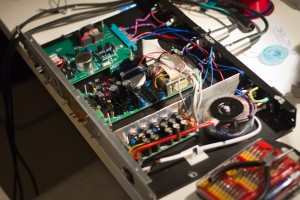
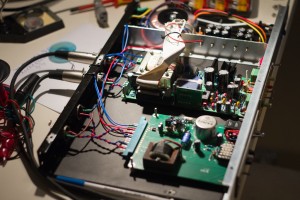
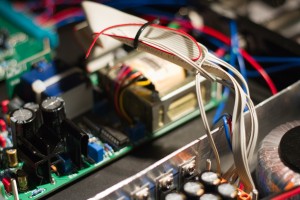
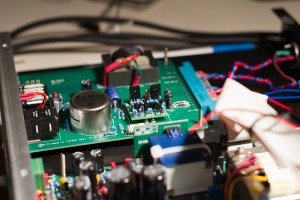
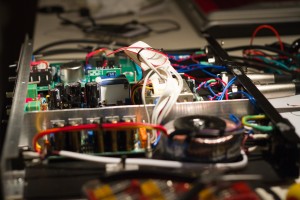
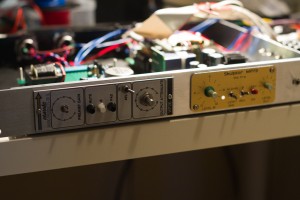
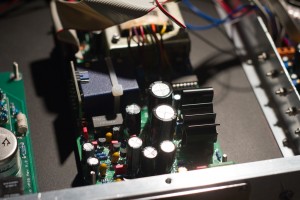
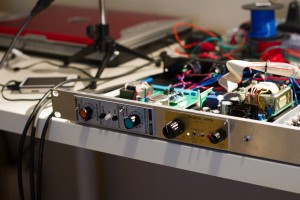
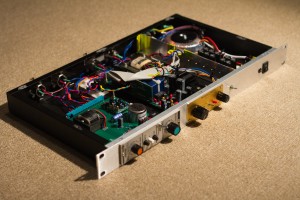
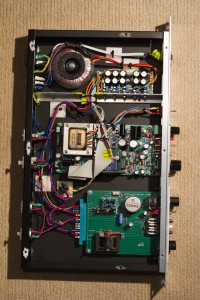
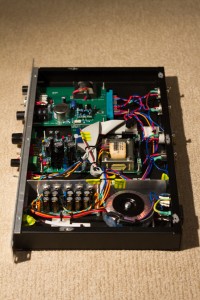
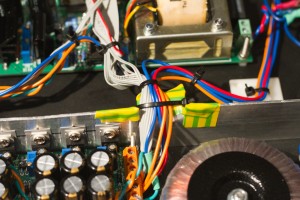
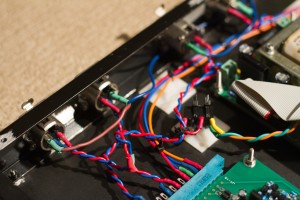
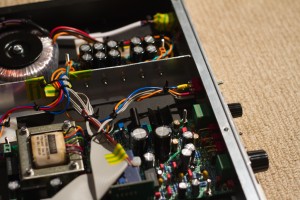
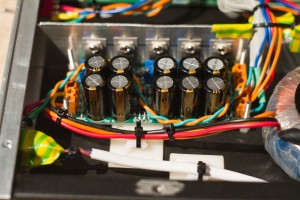
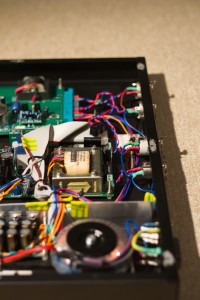
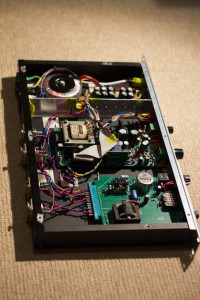
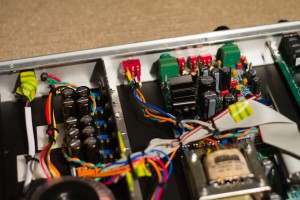
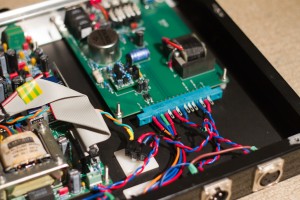
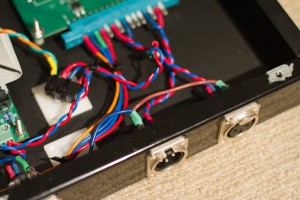
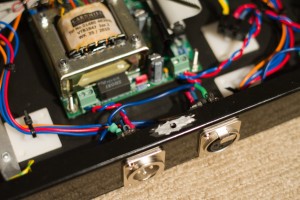
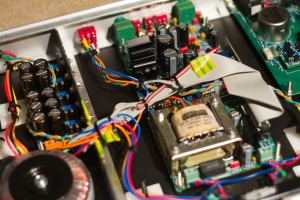
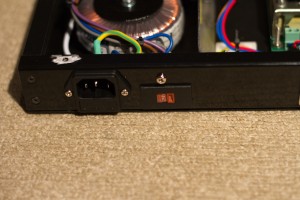
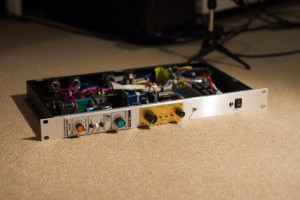
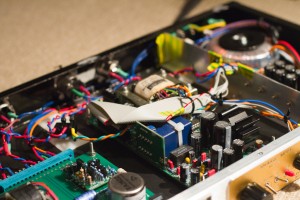
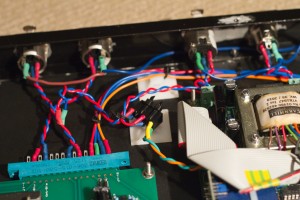
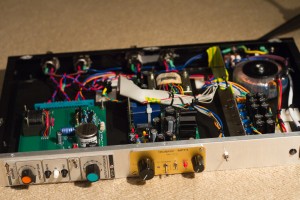
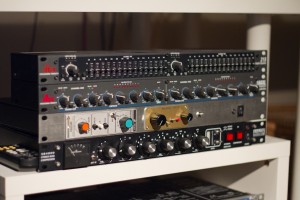
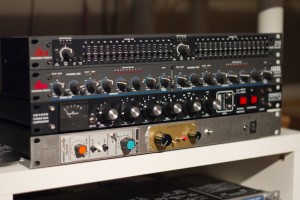
#WIN! So excited to try these pre-amps!
Hey, great site! Glad I stumbled here from the GroupDIY forum. Just to let you know, I added links to your articles from the directory at diyrecordingequipment.com.
Looking forward to the next project….
-Peterson
Thanks so much Peterson!
Hi, Great site!!! Discuss anything about CNC machines, programing, troubleshooting, retrofits at MachinistsForum
Hey, I’ve been looking into doing something similar, what parts did you use for powering it and how many modules would it be able to power if the right connectors were added? Thanks a lot, this is great stuff.
Hi Zach!
I used the following power supply from JLM Audio: http://www.jlmaudio.com/shop/index.php?_a=viewProd&productId=12, which I used to derive the needed +-16V, +-24V and +48V for phantom that were needed ( hence the 5 regulators in total ).
This also had the advantage that each amp was running on different regulators ( the API on the +-16V and the Neve on the +-24V ) to reduce cross-talk and interaction between them. Using more devices on one of the rails would perform slightly differently due to this but would still most likely work fine.
Here is one you could use if you needed to run only phantom and +-V rails: http://www.jlmaudio.com/shop/index.php?_a=viewProd&productId=11, but that depends if you need phantom power or not.
I am not sure how many modules you could power with one PSU, since this also depends on the transformer. But in theory a 50VA transformer could tidily power 0.5A of power, and since each draws MAX like 100-400mA, then you could probably comfortably fit about 10 of them in there with no worries.
cheers,
Luke
Hi Luke,
Thanks for posting this. I am working on building some stomp boxes at the mo and am looking forward to building a couple of the SK pres. I’m wondering about the enclosure/PSU. In general was it cheaper and less hassle to build your own, and is there really much saving in time/money/hassle to make it work while?
It is of course, nice to roll your own but all these things do have an overhead and I’m wondering if it would be the line of least resistance to just get the enclosure and PSU from SK. They are pricey tho..
Cheers
Josh
Hi Joshue,
The enclose including all costs came to: $341.191AUD – this includes the PSU and all connectors etc. – so take those numbers for what you will.
I had to obviously rack it manually since I had to include the ClassicAPI VP26.
Also racking the MP73 is extremely difficult to do without their cases, since they’ve built in various gotchas to ensure it’s difficult. For instance there are relays to provide power to and various other connections required of the card connector to ensure it powers up and operates correctly.
Theoretically if you just want to ensure it works properly the best option is still quite likely to buy their case. If you are extremely competent with electronics then racking it yourself provides a lot of good options for you.
I hope that helps!
L
Whoa, nicely done!
Thank you!